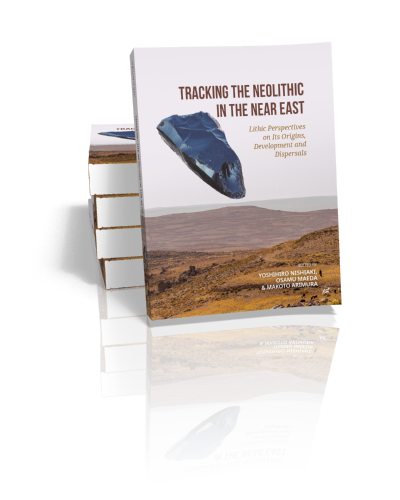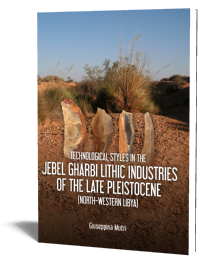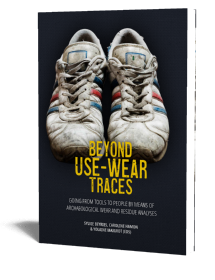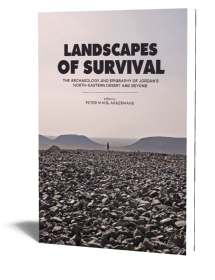Tracking the Neolithic in the Near East
Lithic Perspectives on Its Origins, Development and Dispersals
Edited by Yoshihiro Nishiaki, Osamu Maeda & Makoto Arimura | 2022

Tracking the Neolithic in the Near East
Lithic Perspectives on Its Origins, Development and Dispersals
Edited by Yoshihiro Nishiaki, Osamu Maeda & Makoto Arimura | 2022
Paperback ISBN: 9789464260809 | Hardback ISBN: 9789464260816 | Imprint: Sidestone Press | Format: 210x280mm | 600 pp. | Language: English | 211 illus. (bw) | 109 illus. (fc) | Keywords: archaeology; lithic industries; neolithic; Near Eastern prehistory; West Asia; obsidian; early farming; hunter-gatherers; neolithisation; Göbekli Tepe; Çatalhöyük | download cover
Read online 856 times
- Digital & Online access
-
Buy via Sidestone (EU & UK)
-
Buy via our Distributors (WORLD)
For non-EU or UK destinations you can buy our books via our international distributors. Although prices may vary this will ensure speedy delivery and reduction in shipping costs or import tax. But you can also order with us directly via the module above.
UK international distributor
USA international distributor
-
Bookinfo
Paperback ISBN: 9789464260809 | Hardback ISBN: 9789464260816 | Imprint: Sidestone Press | Format: 210x280mm | 600 pp. | Language: English | 211 illus. (bw) | 109 illus. (fc) | Keywords: archaeology; lithic industries; neolithic; Near Eastern prehistory; West Asia; obsidian; early farming; hunter-gatherers; neolithisation; Göbekli Tepe; Çatalhöyük | download cover
Read online 856 times

We will plant a tree for each order containing a paperback or hardback book via OneTreePlanted.org.
This book combines the latest studies of Near Eastern Neolithic lithics by leading international archaeologists to develop their analytical potential and advance our understanding of the world oldest farming societies of the Near East in human history.
This volume presents the proceedings of the 9th International Conference of the Pre-Pottery Neolithic Chipped and Ground Stone Industries of the Near East, hosted at the University of Tokyo, Japan, from November 12 to 16, 2019 (PPN9-Tokyo).
A unique point of the volume, while referring to the origins and development as in the proceedings of the previous conferences, is a greater emphasis on regional perspectives to evaluate the Near Eastern Neolithic. The current research indicates that the earliest farming societies of the Near East developed in interaction with neighbouring hunter-gatherer societies, that either coexisted with them for long periods or soon assimilated to the Near Eastern farmers. Understanding these contrasting processes would shed new light on identifying the Neolithisation practices of the “core” regions in the Near East itself. A similar attempt was made at the PPN2-Warsaw in 1995, but the present volume provides the most up-to-date discoveries and perspectives after a quarter century.
The 39 papers in this volume include contributions on the Iranian Zagros, the Caucasus, and Central Asia, a region whose Neolithic archaeological records are far less well understood but that we believe will enrich our understanding of the first farming societies of the Near East.
PREFACE
Y. NISHIAKI, O. MAEDA & M. ARIMURA
PART 1: NEW DISCOVERIES IN THE LEVANT
THE PRODUCTION AND USE OF DISTINCTIVE LITHIC OBJECTS
Drilling Tools at the End of the Natufian: Suggesting a Technological Innovation
T. YASHUV & L. GROSMAN
Arrows and Archery during the PPNB: An Experimental Approach: Points Production and Use
F. ABBÈS & F. PICHON
Weapons or Hunting Tools? Evaluating the Role of Big Arrowheads of the Neolithic Levant
O. BARZILAI & H. MAY
3D Morpho-Metric Analysis of PPNB Arrowheads from MOTZA: Preliminary Results
H. KHALAILY, K. VARDI, A. KARASIK & O. BARZILAI
Production and Use of Nahal Hemar Knives in the Southern Levant during the PPNB: New Evidence from Kharaysin (Jordan)
F. BORRELL, J.J. IBÁÑEZ, J. MUÑIZ, I. CLEMENTE CONTE & L. TEIRA
The Baʻja Daggers: Type, Technology and Commodification of a LPPNB Burial Object
H.G.K. GEBEL, C. PURSCHWITZ, D. ŠTEFANISKO & M. BENZ
Recycling of PPNB Artefacts in the Yarmukian Site of Tel Izhaki, Jezreel Valley, Israel: Some Chronological and Regional Implications
A. YAROSHEVICH, E.C.M. van den BRINK, R. CHASAN, D. ROSENBERG, A. BIELER, L. PERRY-GAL, E. BOARETTO & N. GREENBAUM
Innovation, Adaptation or Just a Development? Alternative Uses of Obsidian the Early Neolithic of the Near East
E. HEALEY and S. CAMPBELL
Typology, Material and Cultural Role of Stone Bracelets (Bangles) from the Neolithic Megasite of Motza: Preliminary Report
I. MILEVSKI, J. VARDI & H. KHALAILY
Flaking or Grinding? Habits of Stone Tool Production in Prehistoric Cyprus
A. MCCARTHY
The Processing of Construction Stones at the Neolithic Site of Mishmar Ha‘emeq, Israel
G. HAKLAY, N. GETZOV & O. BARZILAI
LITHIC ASSEMBLAGES AND KNAPPING TECHNOLOGIES
Refitting Lithics from Ais Giorkis, Cyprus: A Preliminary Analysis of Bidirectional Blade Technology
C. MCCARTNEY
Preliminary Analysis of the Lithic Assemblages of Nahal Yarmuth 38: A New PPNB Site in Central Israel
D. ACKERFELD, A. EIRIKH-ROSE, H. ASHKENAZI, K. ZUTOVSKI & A. GOPHER
Intra-Site Variability in the Pre-Pottery Neolithic B Site of Yiftahel: Lithic Techno-Typological Analysis
A. LEVY, N GETZOV, H. KHALAILY, I. MILEVSKI & O. MARDER
Skill, Learning and Knowledge Transfer in Lithic Production as Seen from LPPNB/FPPNB Baʻja, Southern Levant
C. PURSCHWITZ
Motza: A Village of the Final Phase of the Pre-Pottery Neolithic B, Preliminary Observations
J. VARDI, D. YEGOROV, A. LEVY, A. SHATIL, N. MITKI & H. KHALAILY
Heat Treatment of Flint in the Early Pre-Pottery Neolithic B Site of Motza (Judean Hills, Israel)
D. YEGOROV, H. KHALAILY & S.A. ROSEN
Tracing the Neolithic Occupation of ‘En Esur (Israel) and the Question of the Archaeological Visibility of the Neolithic in the Archeological Record: The Lithic Perspective
L. BRAILOVSKY-ROKSER, D. SHALEM & M. BIRKENFELD
PART 2: VIEWS FROM NEIGHBORING REGIONS
LITHICS FROM ARID LANDS
Hunting in the Dunes: Evidence for Late Natufian Hunting Practices in the Northwestern Negev Site of Ashalim
L. EDELTIN, J. VARDI & O. MARDER
Chipped Stone Tool Production Strategies at Nahal Efe (northern Negev) during the Middle Pre-Pottery Neolithic B
F. BORRELL & J. VARDI
The Ghassanian Techno-Complex: Late/Final PPNB Lithic Assemblages from Desert Kite-Associated Occupation Sites in Jibal al-Khashabiyeh, South-Eastern Jordan
R. CRASSARD, J.A. SÁNCHEZ PRIEGO, F. PICHON, W. ABU-AZIZEH & M. TARAWNEH
Harrat Juhayra 202 and the Jordanian Badia Early PPNB: Fresh Perspective on the PPNA/PPNB Transition in the Southern Levant
S. FUJII
Go West: New Discoveries Concerning the PPNB in the Eastern Desert of Egypt between the Sinai and the Nile Valley
F. BRIOIS, B. MIDANT-REYNES & Y. TRISTANT
The Local Development and Levantine Influence Seen in the Stone Tools of the Fayum Neolithic in Egypt
N. SHIRAI
NEW PERSPECTIVES FROM ANATOLIA
A Prehistoric Survey in Cappadocia and a New Early Holocene Site, Balıklı: Preliminary Insights into the Local Chipped Stone Industries
N. KAYACAN, A.N. GORING-MORRIS, G. DURU & M. ÖZBAŞARAN
Sırçalıtepe: A New Aceramic Neolithic Site in Volcanic Cappadocia (Central Anatolia)
S. BALCI & Ç. ALTINBILEK-ALGÜL & D. MOURALIS
Chipped Stone at the Late Neolithic TPC Area, Çatalhöyük: On-Site and Beyond
H.C. SCHECHTER
Tepecik Çiftlik (Turkey) and the Exploitation of Cappadocian Obsidian during the 7th Millennium
D. GUILBEAU
The Lithic Assemblages of Gusir Höyük: A Pre-Pottery Neolithic Site on the Upper Tigris Basin (Southeast Anatolia)
Ç. ALTINBILEK-ALGÜL, S. BALCI, D. MOURALIS & O. D. ASLANER
Change and Continuity in the Lithic Industry of Hasankeyf Höyük, a late 10th millennium cal. BC Site on the Upper Tigris O. MAEDA, T. CARTER & R. MOIR
“[…] but it is not clear at all where all the […] debris had been taken from […]” Chipped Stone Artefacts, Architecture and Site Formation Processes at Göbekli Tepe
J. BREUERS and KINZEL
LITHICS FROM FURTHER EAST
Exploring the Changes in Lithic Industries during the Neolithisation in Armenia (7th–6th millennium BCE): A Comparison of Chipped Stone Tools from Lernagog-1 and Masis Blur
M. ARIMURA, K. MARTIROSYAN-OLSHANSKY, A. PETROSYAN & B. GASPARYAN
Neolithic Chipped Stone Industry of Mentesh Tepe (Middle Kura Valley, Azerbaijan): Technological Markers and Relations to North-Eastern Anatolia
L. ASTRUC, D. GUILBEAU, B. GRATUZE, C. CHATAIGNER, O. BARGE, B. LYONNET & F. GULIYEV
Discard Patterns of Chipped and Ground Stone Refuse at Hacı Elamxanlı Tepe in the Southern Caucasus: Implications for the Residential Mobility and the Neolithization Process
S. KADOWAKI, F. GULIYEV & Y. NISHIAKI
Neolithic Sickles of the South Caucasus and North Mesopotamia (early 6th millennium BC)
Y. NISHIAKI
A Brand New Thing: Bladelet Production Techniques and Methods in Caspian Mesolithic and Neolithic Chipped Stone Industries
M. JAYEZ & H.V. NASAB
Towards Understanding the Early Neolithic in the Zagros Mountains: Results of New Investigations of the Austro-Iranian Team in Ilam Province, Iran
B. MILIĆ, B. HOREJS & L. NIAKAN
Returning to Hunting and Re-microlithisation during the Mushki Phase in Fars, Southwest Iran
M. ABE, S. ARAI & M. KHANIPOUR
The Symbolic Meaning of the Neolithic Manuports: The Examples from Nemrik 9, Northern Iraq, and Ayakagytma ‘The Site’, Uzbekistan
K. SZYMCZAK
Prof dr. Yoshihiro Nishiaki
Yoshihiro Nishiaki, born in 1961, received his BA and MA from the University of Tokyo, and Ph.D. from University College London. He has been a full professor of prehistoric archaeology at the University of Tokyo since 2006 and Director of the University of Tokyo Museum since 2020. His major research interest is concerned with the prehistory of West and Central Asia, particularly the origins and development of farming socio-economy and the replacement of Neanderthals by anatomically modern humans in those regions.
Dr. Osamu Maeda
Osamu Maeda received his BA and MA degrees from University of Tsukuba and Ph.D. from University of Manchester. He has been a researcher at University of Tsukuba since 2015 and currently is an associate professor in the archaeology course and a head of the archaeology division of the Research Center for West Asian Civilization. He is recently conducting international collaborative research as a member of the Manchester Obsidian Laboratory. His 25 years-experience of fieldworks in the Near East includes excavations of Neolithic sites by international teams in Syria, Turkey and Iraq-Kurdistan.
Prof. dr. Makoto Arimura
Makoto Arimura is a professor at Tokai University, Japan. He obtained his undergraduate degree in archaeology (1995) from the University of Tsukuba, Japan, under Professor Akira Tsuneki, and his PhD in archaeology (2007) from the Université Lumière Lyon 2, France, under Professor Olivier Aurenche and Dr Éric Coqueugniot. After a project assistant post at the Research Institute for Humanity and Nature (RIHN), Kyoto (2006), he worked at the Tokyo National Research Institute for Cultural Properties (NRICP) as a research fellow (2007–2012). His primary research topic is the transformation of human society during Neolithisation, through changes in material culture, particularly the transition of stone tool manufacturing technology in the Neolithic Near East.
Abstract:
This book combines the latest studies of Near Eastern Neolithic lithics by leading international archaeologists to develop their analytical potential and advance our understanding of the world oldest farming societies of the Near East in human history.
This volume presents the proceedings of the 9th International Conference of the Pre-Pottery Neolithic Chipped and Ground Stone Industries of the Near East, hosted at the University of Tokyo, Japan, from November 12 to 16, 2019 (PPN9-Tokyo).
A unique point of the volume, while referring to the origins and development as in the proceedings of the previous conferences, is a greater emphasis on regional perspectives to evaluate the Near Eastern Neolithic. The current research indicates that the earliest farming societies of the Near East developed in interaction with neighbouring hunter-gatherer societies, that either coexisted with them for long periods or soon assimilated to the Near Eastern farmers. Understanding these contrasting processes would shed new light on identifying the Neolithisation practices of the “core” regions in the Near East itself. A similar attempt was made at the PPN2-Warsaw in 1995, but the present volume provides the most up-to-date discoveries and perspectives after a quarter century.
The 39 papers in this volume include contributions on the Iranian Zagros, the Caucasus, and Central Asia, a region whose Neolithic archaeological records are far less well understood but that we believe will enrich our understanding of the first farming societies of the Near East.
Contents
PREFACE
Y. NISHIAKI, O. MAEDA & M. ARIMURA
PART 1: NEW DISCOVERIES IN THE LEVANT
THE PRODUCTION AND USE OF DISTINCTIVE LITHIC OBJECTS
Drilling Tools at the End of the Natufian: Suggesting a Technological Innovation
T. YASHUV & L. GROSMAN
Arrows and Archery during the PPNB: An Experimental Approach: Points Production and Use
F. ABBÈS & F. PICHON
Weapons or Hunting Tools? Evaluating the Role of Big Arrowheads of the Neolithic Levant
O. BARZILAI & H. MAY
3D Morpho-Metric Analysis of PPNB Arrowheads from MOTZA: Preliminary Results
H. KHALAILY, K. VARDI, A. KARASIK & O. BARZILAI
Production and Use of Nahal Hemar Knives in the Southern Levant during the PPNB: New Evidence from Kharaysin (Jordan)
F. BORRELL, J.J. IBÁÑEZ, J. MUÑIZ, I. CLEMENTE CONTE & L. TEIRA
The Baʻja Daggers: Type, Technology and Commodification of a LPPNB Burial Object
H.G.K. GEBEL, C. PURSCHWITZ, D. ŠTEFANISKO & M. BENZ
Recycling of PPNB Artefacts in the Yarmukian Site of Tel Izhaki, Jezreel Valley, Israel: Some Chronological and Regional Implications
A. YAROSHEVICH, E.C.M. van den BRINK, R. CHASAN, D. ROSENBERG, A. BIELER, L. PERRY-GAL, E. BOARETTO & N. GREENBAUM
Innovation, Adaptation or Just a Development? Alternative Uses of Obsidian the Early Neolithic of the Near East
E. HEALEY and S. CAMPBELL
Typology, Material and Cultural Role of Stone Bracelets (Bangles) from the Neolithic Megasite of Motza: Preliminary Report
I. MILEVSKI, J. VARDI & H. KHALAILY
Flaking or Grinding? Habits of Stone Tool Production in Prehistoric Cyprus
A. MCCARTHY
The Processing of Construction Stones at the Neolithic Site of Mishmar Ha‘emeq, Israel
G. HAKLAY, N. GETZOV & O. BARZILAI
LITHIC ASSEMBLAGES AND KNAPPING TECHNOLOGIES
Refitting Lithics from Ais Giorkis, Cyprus: A Preliminary Analysis of Bidirectional Blade Technology
C. MCCARTNEY
Preliminary Analysis of the Lithic Assemblages of Nahal Yarmuth 38: A New PPNB Site in Central Israel
D. ACKERFELD, A. EIRIKH-ROSE, H. ASHKENAZI, K. ZUTOVSKI & A. GOPHER
Intra-Site Variability in the Pre-Pottery Neolithic B Site of Yiftahel: Lithic Techno-Typological Analysis
A. LEVY, N GETZOV, H. KHALAILY, I. MILEVSKI & O. MARDER
Skill, Learning and Knowledge Transfer in Lithic Production as Seen from LPPNB/FPPNB Baʻja, Southern Levant
C. PURSCHWITZ
Motza: A Village of the Final Phase of the Pre-Pottery Neolithic B, Preliminary Observations
J. VARDI, D. YEGOROV, A. LEVY, A. SHATIL, N. MITKI & H. KHALAILY
Heat Treatment of Flint in the Early Pre-Pottery Neolithic B Site of Motza (Judean Hills, Israel)
D. YEGOROV, H. KHALAILY & S.A. ROSEN
Tracing the Neolithic Occupation of ‘En Esur (Israel) and the Question of the Archaeological Visibility of the Neolithic in the Archeological Record: The Lithic Perspective
L. BRAILOVSKY-ROKSER, D. SHALEM & M. BIRKENFELD
PART 2: VIEWS FROM NEIGHBORING REGIONS
LITHICS FROM ARID LANDS
Hunting in the Dunes: Evidence for Late Natufian Hunting Practices in the Northwestern Negev Site of Ashalim
L. EDELTIN, J. VARDI & O. MARDER
Chipped Stone Tool Production Strategies at Nahal Efe (northern Negev) during the Middle Pre-Pottery Neolithic B
F. BORRELL & J. VARDI
The Ghassanian Techno-Complex: Late/Final PPNB Lithic Assemblages from Desert Kite-Associated Occupation Sites in Jibal al-Khashabiyeh, South-Eastern Jordan
R. CRASSARD, J.A. SÁNCHEZ PRIEGO, F. PICHON, W. ABU-AZIZEH & M. TARAWNEH
Harrat Juhayra 202 and the Jordanian Badia Early PPNB: Fresh Perspective on the PPNA/PPNB Transition in the Southern Levant
S. FUJII
Go West: New Discoveries Concerning the PPNB in the Eastern Desert of Egypt between the Sinai and the Nile Valley
F. BRIOIS, B. MIDANT-REYNES & Y. TRISTANT
The Local Development and Levantine Influence Seen in the Stone Tools of the Fayum Neolithic in Egypt
N. SHIRAI
NEW PERSPECTIVES FROM ANATOLIA
A Prehistoric Survey in Cappadocia and a New Early Holocene Site, Balıklı: Preliminary Insights into the Local Chipped Stone Industries
N. KAYACAN, A.N. GORING-MORRIS, G. DURU & M. ÖZBAŞARAN
Sırçalıtepe: A New Aceramic Neolithic Site in Volcanic Cappadocia (Central Anatolia)
S. BALCI & Ç. ALTINBILEK-ALGÜL & D. MOURALIS
Chipped Stone at the Late Neolithic TPC Area, Çatalhöyük: On-Site and Beyond
H.C. SCHECHTER
Tepecik Çiftlik (Turkey) and the Exploitation of Cappadocian Obsidian during the 7th Millennium
D. GUILBEAU
The Lithic Assemblages of Gusir Höyük: A Pre-Pottery Neolithic Site on the Upper Tigris Basin (Southeast Anatolia)
Ç. ALTINBILEK-ALGÜL, S. BALCI, D. MOURALIS & O. D. ASLANER
Change and Continuity in the Lithic Industry of Hasankeyf Höyük, a late 10th millennium cal. BC Site on the Upper Tigris O. MAEDA, T. CARTER & R. MOIR
“[…] but it is not clear at all where all the […] debris had been taken from […]” Chipped Stone Artefacts, Architecture and Site Formation Processes at Göbekli Tepe
J. BREUERS and KINZEL
LITHICS FROM FURTHER EAST
Exploring the Changes in Lithic Industries during the Neolithisation in Armenia (7th–6th millennium BCE): A Comparison of Chipped Stone Tools from Lernagog-1 and Masis Blur
M. ARIMURA, K. MARTIROSYAN-OLSHANSKY, A. PETROSYAN & B. GASPARYAN
Neolithic Chipped Stone Industry of Mentesh Tepe (Middle Kura Valley, Azerbaijan): Technological Markers and Relations to North-Eastern Anatolia
L. ASTRUC, D. GUILBEAU, B. GRATUZE, C. CHATAIGNER, O. BARGE, B. LYONNET & F. GULIYEV
Discard Patterns of Chipped and Ground Stone Refuse at Hacı Elamxanlı Tepe in the Southern Caucasus: Implications for the Residential Mobility and the Neolithization Process
S. KADOWAKI, F. GULIYEV & Y. NISHIAKI
Neolithic Sickles of the South Caucasus and North Mesopotamia (early 6th millennium BC)
Y. NISHIAKI
A Brand New Thing: Bladelet Production Techniques and Methods in Caspian Mesolithic and Neolithic Chipped Stone Industries
M. JAYEZ & H.V. NASAB
Towards Understanding the Early Neolithic in the Zagros Mountains: Results of New Investigations of the Austro-Iranian Team in Ilam Province, Iran
B. MILIĆ, B. HOREJS & L. NIAKAN
Returning to Hunting and Re-microlithisation during the Mushki Phase in Fars, Southwest Iran
M. ABE, S. ARAI & M. KHANIPOUR
The Symbolic Meaning of the Neolithic Manuports: The Examples from Nemrik 9, Northern Iraq, and Ayakagytma ‘The Site’, Uzbekistan
K. SZYMCZAK
Prof dr. Yoshihiro Nishiaki
Yoshihiro Nishiaki, born in 1961, received his BA and MA from the University of Tokyo, and Ph.D. from University College London. He has been a full professor of prehistoric archaeology at the University of Tokyo since 2006 and Director of the University of Tokyo Museum since 2020. His major research interest is concerned with the prehistory of West and Central Asia, particularly the origins and development of farming socio-economy and the replacement of Neanderthals by anatomically modern humans in those regions.
Dr. Osamu Maeda
Osamu Maeda received his BA and MA degrees from University of Tsukuba and Ph.D. from University of Manchester. He has been a researcher at University of Tsukuba since 2015 and currently is an associate professor in the archaeology course and a head of the archaeology division of the Research Center for West Asian Civilization. He is recently conducting international collaborative research as a member of the Manchester Obsidian Laboratory. His 25 years-experience of fieldworks in the Near East includes excavations of Neolithic sites by international teams in Syria, Turkey and Iraq-Kurdistan.
Prof. dr. Makoto Arimura
Makoto Arimura is a professor at Tokai University, Japan. He obtained his undergraduate degree in archaeology (1995) from the University of Tsukuba, Japan, under Professor Akira Tsuneki, and his PhD in archaeology (2007) from the Université Lumière Lyon 2, France, under Professor Olivier Aurenche and Dr Éric Coqueugniot. After a project assistant post at the Research Institute for Humanity and Nature (RIHN), Kyoto (2006), he worked at the Tokyo National Research Institute for Cultural Properties (NRICP) as a research fellow (2007–2012). His primary research topic is the transformation of human society during Neolithisation, through changes in material culture, particularly the transition of stone tool manufacturing technology in the Neolithic Near East.
- Digital & Online access
-
Buy via Sidestone (EU & UK)
-
Buy via our Distributors (WORLD)
For non-EU or UK destinations you can buy our books via our international distributors. Although prices may vary this will ensure speedy delivery and reduction in shipping costs or import tax. But you can also order with us directly via the module above.
UK international distributor
USA international distributor
- Browse all books by subject
-
Search all books

We will plant a tree for each order containing a paperback or hardback book via OneTreePlanted.org.
You might also like:
© 2025 Sidestone Press KvK nr. 28114891 Privacy policy Sidestone Newsletter Terms and Conditions (Dutch)








